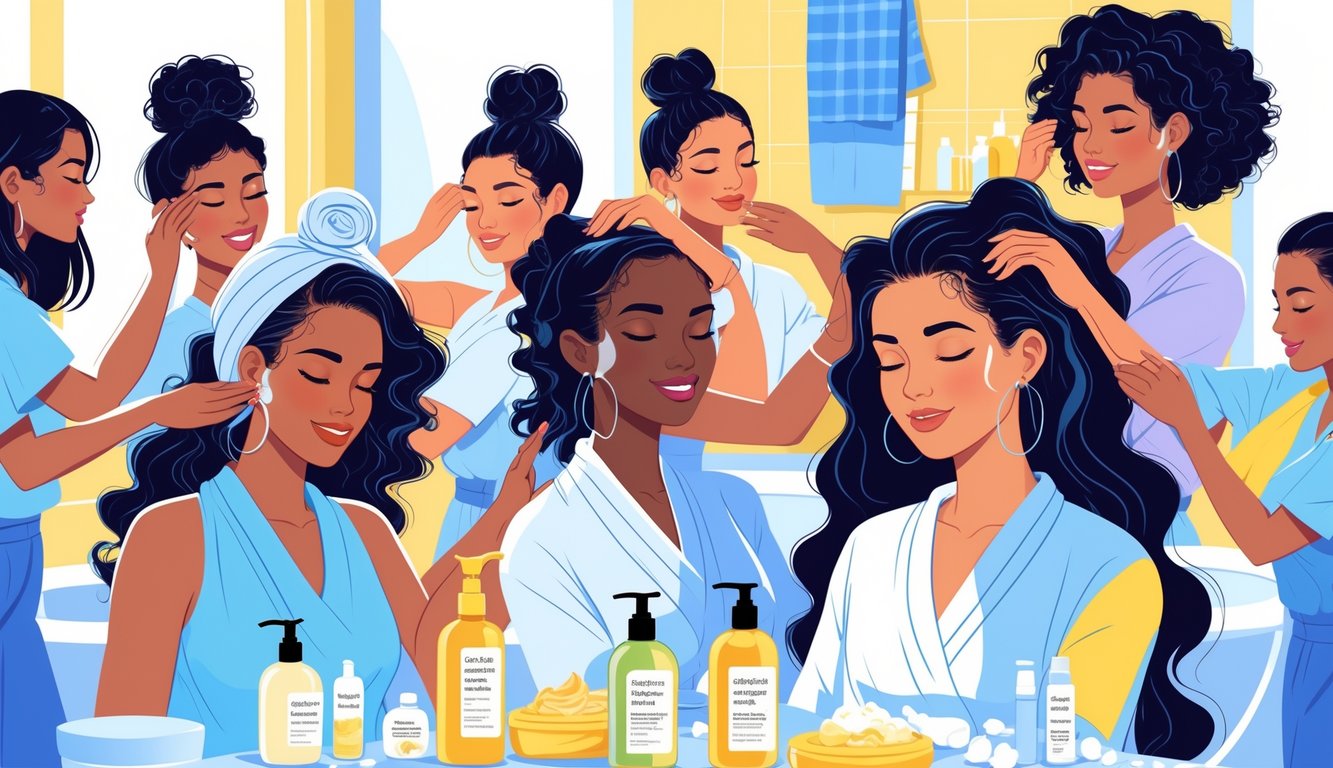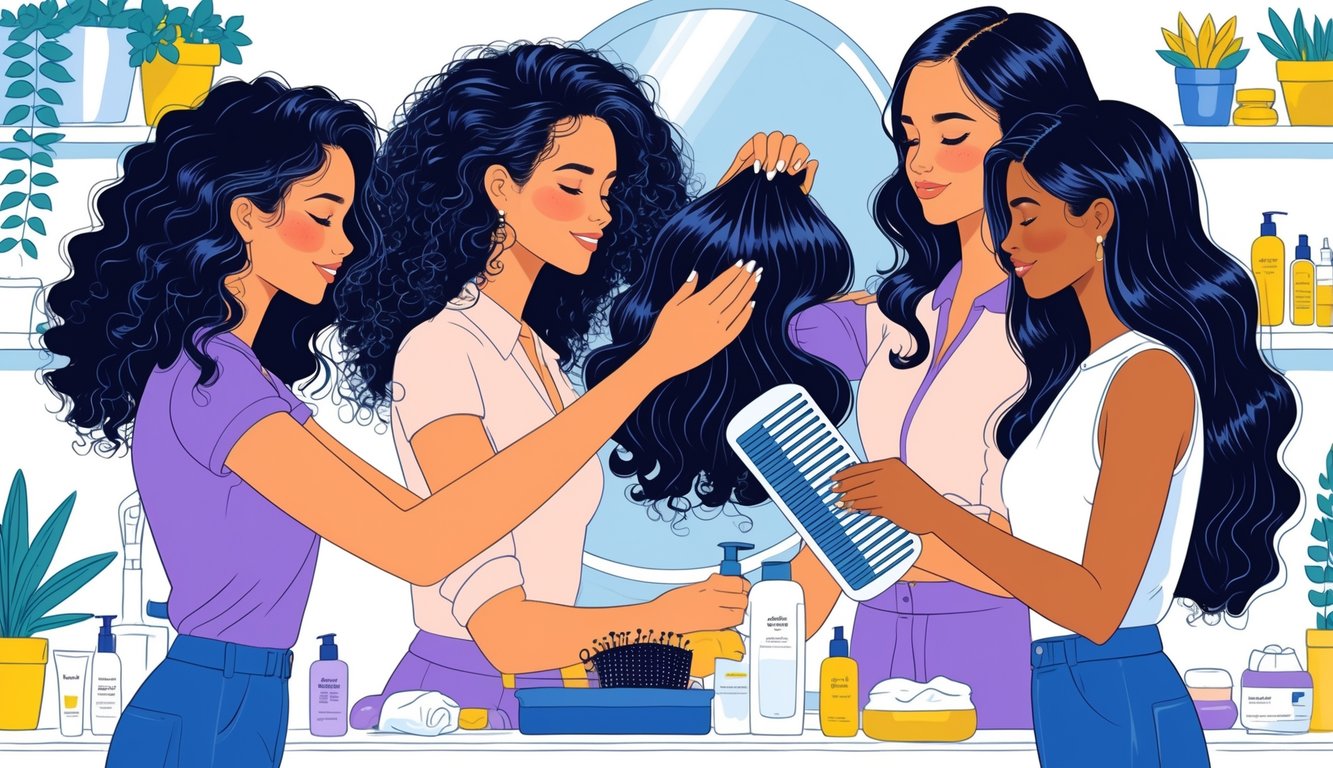
Troubleshooting: Common Deep Conditioning Mistakes

I rinse and rinse, and my roots still cling to my scalp like plastic wrap. Ends? Dry as toast. Following salon advice is supposed to fix this, but nope. It’s like, human error, product confusion, hard water, and always running late.
Product Buildup and How to Prevent It
I didn’t realize how much junk gets stuck in my hair. Doesn’t matter if it’s a shea butter mask or some “detox” cream—sometimes my hair just droops. Product buildup is obvious. flawlesshair.com says people skip pre-wash detangling and then wonder why their conditioner just sits there.
Weird white bits in my brush? Not dandruff. Just dried-up conditioner. Stylists I trust always clarify before deep conditioning. Yes, sulfate shampoo. It doesn’t always kill your color. Table (because apparently I’m tracking this now):
| Week | Wash Method | Scalp Feel |
|---|---|---|
| 1 | Clarify + DC | Clean, light |
| 2 | DC Only | Greasy, filmy |
People say, “Just co-wash!” Sure, and then watch your scalp suffocate under layers of product. If my hair refuses to hold volume, I know it’s time to deep cleanse, not double down on conditioner.
Balancing Moisture for Different Hair Textures
Everyone’s obsessed with “moisture is key,” but try slapping coconut oil on fine hair—hello, pillowcase disaster. Curls? They’ll drink a gallon of conditioner and still frizz if the formula’s off. Honestly, every hair texture needs its own playbook, and nobody’s porosity charts match up, ever.
A stylist told me, “pH is everything.” Feels dramatic, but apparently, acidic deep conditioners (pH 4.5-5.5) help close the cuticle, lock in hydration. What people miss: thick hair needs heavy, slow-absorbing stuff, but straight, limp hair gets overloaded instantly. Luckslist says if you ignore pH, your hair swings from greasy to desert-dry on a whim.
Once I mixed a light leave-in with a heavy mask. Mistake. Split ends for a week. Ignore the formula’s texture and you pay. Hair porosity charts? I’ve never seen anyone use one in the shower.
Avoiding Flat or Limp Roots After Treatment
What drives me nuts—this myth that more product equals better hair. Slap deep conditioner on your roots and watch your hair stick to your head like a helmet. I see people do this all the time, then complain they have no volume.
Conditioners for shine usually swamp the roots, so your volume’s gone before you even style. Too much at the scalp just makes hair look dirtier, faster. I see this after protein-heavy treatments—hair just sits there, unmoving, and you start thinking about hats.
Pro move: Keep deep conditioners below the ears. Or flip your head upside down for root lift, but then water runs down your neck and you regret everything. Afterward, I skip heavy creams, just puff some light mousse on the roots. Unless it’s raining—then, honestly, who cares. If you want the science on product overload, Glam’s breakdown is a wild ride.
Enhancing the Results: Ingredients That Boost Volume
Why’s everyone chasing the next miracle ingredient when the basics—biotin, good oils, humectants—are already in half the bottles at the salon? Stylists obsess for a reason, but people just want a shortcut.
Biotin and Amino Acids for Strength
Every appointment, someone asks if biotin is real. Look, hair is mostly keratin, so yeah, amino acids like cysteine and methionine matter. Biotin? Unless you’re deficient, it’s not going to change your life, but brands use it anyway because it sounds good and can help prevent breakage in fine hair.
I’ve tried thickening conditioners with biotin next to basic ones. Sometimes the root-lift feels stiffer, and stylists actually notice. Amino acids? Hydrolyzed proteins help. If “strengthened cuticles” means less hair in my brush, I’ll take it. But then there are people who shampoo once a week thinking that’ll make their hair thicker. Nope.
Clinical data says amino acids boost tensile strength (whatever that means—something about less breakage). L’Oreal’s research swears hydrolyzed wheat protein gives visible volume. Do what you want with that info.
Plant Oils and Natural Extracts
A client once asked if castor oil and avocado oil would make her look like she had extensions. I laughed—sorry, but no. They do swell the hair shaft for a bit, though. Fatty acids and vitamin E coat strands, so you get a little fullness, but don’t expect a miracle.
Most volumizing formulas I see use shea butter for slip, castor oil to seal in moisture (because static is the enemy), and avocado oil for shine. Argan oil? It’s more about smoothing than thickening. Botanicals like bamboo and baobab are there for antioxidants, which just means your color might last longer.
My supplier once showed me a table of plant oils by comedogenic rating. Nobody cares, but if you have natural hair, low-comedogenic stuff matters (clogged follicles, no thanks). Marketers need to stop saying argan oil “lifts” anything. It doesn’t.
Honey, Aloe Vera, and Other Volume Helpers
People get weird about honey. Does it thicken hair? Not exactly. It’s a humectant, so it pulls in moisture and can puff up the hair shaft a bit. I keep a spray with aloe vera around for flyaways and body, but if I use too much, my roots go limp.
Aloesin in aloe vera? Stylists love talking about it—studies say it boosts hair growth activity (see this study), but I’ve never seen anyone’s hair look thicker on camera. It’s more about comfort. Add panthenol, honey, fruit extracts—your hair gets flexible, less breakage, but the volume boost is short-lived. In dry weather, maybe you get one extra day.
I did a “natural volume test” for TikTok—no silicones, just honey and aloe. One frizzy day, one soft day, then chaos. Nobody warns you how sticky honey is when it clogs your shower drain.
Maintaining Healthy, Voluminous Hair Long-Term
Split ends keep coming, hair keeps deflating, no matter what mousse I buy or how careful I am with heat tools. Apparently, it’s endless—trim, protect, obsess about your pillowcase. Stylists swear this is the only way to keep bounce. Nobody mentions the grind when you see those shiny hair photos.
Frequency of Trims and Haircuts
Snip, snip. People say “every eight weeks,” but who actually does that? If you want volume and movement, you can’t skip trims. Split ends drag everything down. My colorist literally groans when I show up with scraggly ends.
New growth gets stringy if you leave dead ends alone. Style experts repeat that regular haircuts are non-negotiable for full hair. Yes, you lose some length, but the illusion of thickness is worth it.
Ever notice thinner ends between cuts? That’s split ends, not just breakage. Even with fine hair, skipping trims is self-sabotage.
Nighttime Hair Care: Silk Pillowcases and More
I can’t sleep, so I overthink everything, including my pillowcase. Silk pillowcases are expensive, but cotton grabs at your hair and causes frizz, breakage, all that. With silk, I wake up with waves, not a bird’s nest. Stylists swear by it. Is it luxury? Maybe. I’m not royalty, but I’ll take it.
“Pineappling” (high, loose ponytail with a scrunchie) looks ridiculous but keeps volume at the roots. I tried a satin bonnet once—looked wild, didn’t care, because my hair didn’t tangle. Overnight deep conditioning masks help, but waking up with soggy hair is not my thing.
Oh, and if you sweat at night, everything gets gross faster—silk or not. Rotate pillowcases, ignore your roommate’s judgmental looks.
Protecting Against Split Ends and Breakage
Split ends. Why do they exist? They’re like that one roommate who leaves dishes in the sink—ignore them, and suddenly, disaster. I swear, every stylist I’ve ever met sounds like a broken record about leave-in conditioners, especially the protein ones, but honestly, not all of them work. Grab the wrong bottle and you end up with limp, greasy hair. Been there, regretted it.
Let’s just admit it: twisting your hair in towels is a crime against humanity. Metal brushes? Why are those still a thing? The switch to a soft microfiber towel and a wide-tooth comb? Life-changing. Or maybe I just want to believe it was. Either way, my hair breaks less now. Coincidence? Maybe.
Also, can we talk about the “never use hot tools” crowd? Who are these people, and do they actually exist? I’m not skipping the blow-dryer, sorry. But, yeah, thermal protectant before heat—fine, I’ll do it. When my hair feels like hay, that Pantene Miracle Rescue deep conditioning mask actually does something. I keep buying it. Maybe I’m gullible, but I see fewer split ends. Or maybe it’s placebo. Whatever.



